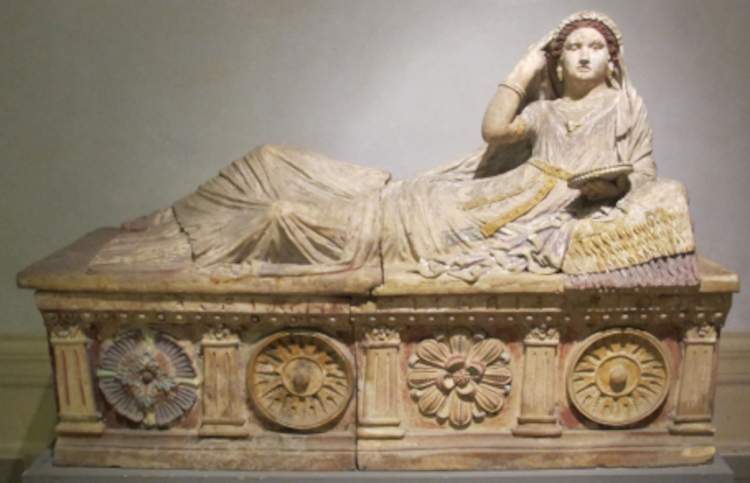March 8: Free admission for all women in Tuscany's museums. Guided tours and themed initiatives
On the occasion of International Women’s Day, on Tuesday, March 8, all women will have free access to Tuscany’s state museums and cultural sites. There will also be an extensive program of guided tours and themed initiatives with museum directors, curators and staff.
In Florence, the curators of the National Archaeological Museum ’s collections will trace the role that female figures have played in history, from ancient Egypt to Etruscan times. At 12 noon Barbara Arbeid will give the talk The instability of categories: male and female in Etruscan religion. Deities of obscure or ambivalent gender are frequent in Etruscan religion: their names, characteristics and cults will be discovered.
In Pisa at the Museo Nazionale di Palazzo Reale the 3 and 5 p.m. tours will also illustrate the portrait of Marie Louise of Austria, second wife of Napoleon I and mother of the only child he recognized. Duchess of Parma by decision of the Congress of Vienna, she was much loved by her people, who bestowed on her the appellation “good duchess” given the important efforts she sustained for the many charitable works carried out in the city for women and the sick: in September 1817 she inaugurated the Maternity Institute and the University Obstetrical Clinic, and she constantly paid much attention to preventing and fighting epidemics, such as the typhus epidemic of 1817 and the cholera epidemic of 1836.
At the National Museum of St. Matthew, the scheduled guided tours at 3:30 p.m. and 5:30 p.m. will also focus on a detail from Simone Martini’s Pisa Polyptych depicting St. Catherine of Alexandria, an 18-year-old daughter of nobles who attempted to dissuade the Emperor Maximinus from pagan worship and was sentenced to a torture after having numerous court intellectuals converted. Many patronages were granted to Catherine: important was the one over theologians and philosophers; she was highly revered in cultured circles, playing a relevant role in the Christian tradition, in the life of religious Orders, and in the history of universities and studies.
Visits to the National Museum of the Monumental Charterhouse of Calci will focus on the presence of the female figure in the history of the Calcesan monastery and the Carthusian Order more generally. Environments and historical events will be told from an unusual point of view, to discover the role and presence of more or less illustrious women at the Charterhouse over the centuries.
At the National Etruscan Museum in Chiusi there is a guided tour at 4 p.m., free and open to all, entitled Women Compared: the condition of women in ancient societies through museum artifacts. Countless aspects of the societies of the ancient world will be told. The presence of women is witnessed in its daily occurrence by everyday objects related to domestic work, such as spools, stoves, but also by evidence related to the funerary sphere such as canopic jars, which often reveal female features and the precise role of women in society, and reliefs and sculptures depicting their participation at public moments such as banquets, weddings and funeral mourning.
The presence of black-figure and red-figure ceramics imported from the Greek world and recovered in the burials of Etruscan aristocrats allows for parallels between the condition of women in ancient Greece and Etruria where women enjoyed extraordinary freedom. A journey that will also lead to acquaintance with singular figures such as Thetis and Eos, female deities who at the same time share a human condition, that of motherhood, on a Tyrrhenian black-figure amphora depicting the duel between their respective sons, Achilles and Memnon; the poignant figure of Penelope, portrayed on a red-figure vase, representing fidelity, woman as guardian of the domestic hearth, but also the ability to oppose an all-male society through the intelligence and cunning represented by the famous cloth, not coincidentally painted on the same vase. In these representations other figures emerge powerfully out of the usual woman-home schema, such as the aetheras, refined and sensual courtesans, and the invaded maenads who accompanied the Dionysian procession, but also women who pay for their condition such as Cassandra, depicted in the vain act of escaping her assailant, Ajax Oileus. The narrative unravels in the other rooms of the museum with sarcophagi, urns, and paintings illustrating aspects related to the fashion, embellishment, and display of luxury and power of Etruscan women who participated in public ceremonies even with the adoption of precise symbols of high status such as the flabellum and parasol. The tour then continues into the Roman and medieval section where other artifacts, anatomical votive offerings, inscriptions, and jewelry will be examined that help to understand some aspects of women’s status in Roman and Lombard society. The visit will end with the exceptional opening of the museum’s exhibition hall, where it will be possible to admire the reconstruction, curated by the City of Chiusi Archaeological Group, of the loculus of tomb A in the Paccianese Necropolis, the last home of a wealthy Etruscan lady. On display inside is the recomposition of a wooden casket, which belonged to the tomb’s owner and contained items for toiletries and personal adornment.
The detailed event schedule of all national state museums, which is constantly being updated, is available at www.beniculturali.it/evento/giornata-internazionale-della-donna-2022
Pictured is the Larthia sarcophagus at the National Archaeological Museum in Florence, Italy.
 |
| March 8: Free admission for all women in Tuscany's museums. Guided tours and themed initiatives |
Warning: the translation into English of the original Italian article was created using automatic tools. We undertake to review all articles, but we do not guarantee the total absence of inaccuracies in the translation due to the program. You can find the original by clicking on the ITA button. If you find any mistake,please contact us.





























